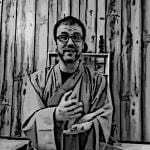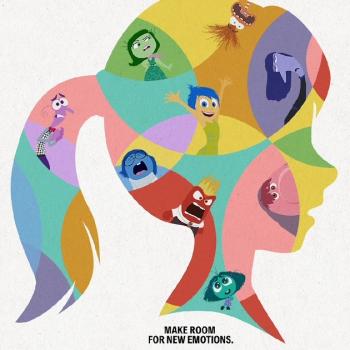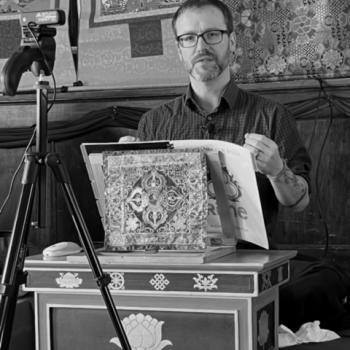Today I’m going to talk about the second arrow. It’s this old teaching about how we relate to our experience. The second arrow is how we tend to magnify our own suffering. The first arrow – this is a metaphor, obviously – is a bad thing that happens, and the second arrow is our way of making it worse.
My two personal examples for this are:
This one time my son threw up, and that in itself is bad. That’s gross and I’ve got to clean that up, right? But that’s not the only thing I’m dealing with, I’m also thinking, “Oh shit, is he sick? Is he going to be sick for a while? Do I have to take him to the doctor? How long is that going to take? Am I going to have to miss work? How many days do I wait before I take him to the doctor? Do I take him today or do I wait until he’s been sick for two days or three days? I don’t know.”
And that is the second arrow, because I’m making myself crazy. The truth is that he just threw up one time and that was it, and he was fine. He went to school the next day and everything, because that’s what kids are sometimes.
I feel like as I get closer to forty, now when I get sick I’m sick a very long time. When I was a kid I was like my son, “Oh, I’m sick for a day then I’m fine.” I look forward to getting older.
My other example is, this one time my tire on my car started to go flat. So then I’m like, “Oh, shit.” Well, I’m going to go to QuikTrip and they’ve got free air. Then at first I think, “There’s going to be a line at QuikTrip for the air because it’s free and there always is.”
I get air in the tire, and then the next day, it’s going flat again, like happens sometimes. So then I’m thinking, “Oh no, now I have to go to a mechanic, maybe they can patch it but probably not. I probably need a new tire. I probably have to miss a day of work because I’m going to be without a car. Cars are inconvenient and annoying.”
That’s what I started telling myself. “I wish I didn’t have to have a car. I wish I worked next door to home,” but of course I don’t. So I’m struggling with all that and then I took my car to Discount Tire and they fixed it in less than an hour. They patched it.
Those are two examples of the second arrow. I had a little problem and I actually made it way worse in my head. That’s what the second arrow is. The first arrow is whatever happens, and then the second arrow is when we struggle with it and we steal our own joy.
The first arrow is inevitable. Things are always going to go wrong. There will be flat tires, always. Life’s not always going to be sunshine and rainbows. The question is, can we learn how to respond better to the second arrow? Or rather, maybe not make the second arrow happen at all. Sometimes we really don’t want anything in life to be less than great, so we get really frustrated and we make our own happiness worse because things don’t go perfectly the way we want them to.
When something happens we don’t like, then sometimes it sets all these mental processes and puts us into a downward spiral. Our minds go wild and we tell all sorts of stories about why things are worse than they really are. I think we all do that. I think we all build things up in our minds. Sometimes when we have unpleasant feelings, we also lash out.
Like, “I’m so mad I’m having this feeling. I’m so mad I’m uncomfortable.” Or, “I’m so mad that I’m sad.” And especially, “How dare you make me feel this way?” We get that way. “How dare you? I deserve to be happy all the time.” And, “I don’t want to feel that.”
The second aspect of the second arrow is what I’m going to call avoidance. That is where we pretend something is not happening. That’s the other level.
I really, really aggressively pretended I was okay when my father passed away. I was not okay, but I pretended I was for a really long time, and that didn’t serve me very well. I think that a lot of us do that, and a lot of us have stories like that. Life is hard, and I also think our culture doesn’t help us very much. We get this message again, and again, and again that just, “I’m going to be happy if I get a new car.” Or, “I’m going to be happy if I get tacos.” Or, “I’m going to be happy if I get Disney+.”
The truth is that burying our sadness by spending money brings fleeting relief. Also, there’s always new things to buy, so we’re going to run out of money that way. People go heavily into debt because they’re trying to buy happiness, I think.
To put it another way, our pain is the first arrow, and the second arrow is our inability to deal with that in a reasonable way. There’s a concept that I like, it’s called apamada. I don’t usually like to talk about foreign language terms, but apamada I like, and it means “the absence of madness.” I think we make ourselves crazy. I really like the word madness for what we’re doing.
We have these experiences where we’re getting hit by the first arrow and we just react and stab ourselves with the second arrow. That’s madness, right?” We just react because we’re not fully present and we’re not seeing things clearly, and we can’t just be here and be like, “Okay, my kid threw up so I’m going to clean that up.” We just go crazy. When we’re mindful, we can choose to respond instead of just reacting. It’s that mindfulness that we’re working on here that we’re developing. To just be aware and not go down this rabbit hole of either sadness or denial.
The mindfulness and awareness is so helpful to us because we can really learn to recognize when we’re making things worse for ourselves. We can choose some of our thoughts, not always, but we can choose some of our thoughts and start to tell ourselves, “Okay, this isn’t that bad, I’m going to get through this. It’s probably going to be okay.” Because a lot of the time, it is okay. Sometimes there are real disasters, of course, but a lot of the time it’s okay.
Sometimes even if we’re mindful we’re going to make things worse anyway, but at least we can learn how to know we’re doing it, and that takes away some of its power. Sometimes we can learn to say, “This isn’t that bad,” or, “My fears are ridiculous.” That can be really helpful.
One of my kids – different kid, not the same one that threw up – whenever he can’t find something, he immediately goes to, “Someone took it.”
So what’s he doing? He’s piling the frustration of losing something, which it sucks to lose something, but he’s piling on anger at a random person. That’s two negative emotions together when it could have been just one. Nobody took it, nobody’s ever taken it. We think we’re not like that, but I think that if we really think about it, we probably have stuff like that, too. He’s making himself unhappy and I’m trying to work with him on that, because that’s no way to go through life.
That’s the first arrow – something’s lost. The second arrow – looking around to place blame. “Who’s fault could this be?” He’s adding to his struggle. I think that we all do that sometimes.
Another thing that happens is we might make a mistake in our life, and that’s the first arrow. The second arrow is just telling ourselves, “I’m worthless. I’m never going to be good at this thing. Other people are better than me.” Just being really down on ourselves. “I’m not good at anything, I’ll never amount to anything.” That’s no good either.
Step one, a bad thing happens. Step two, blame ourselves or others. And sometimes, step three is just trying to get rid of it. Distract yourself, pretend it’s not happening. Go shopping. Drink. Lie to yourself.
I don’t want you to think that avoiding the second arrow means pretending the first arrow didn’t happen. Denial is a different kind of second arrow. Really, the second arrow is whatever stops us from dealing with what’s happening in a skillful way. Facing it properly. Meditation helps us see through our crap so we can see what we’re doing to ourselves, and we can learn to witness what we’re doing instead of just being all caught up in ourselves all the time. Just thinking, “Oh, who took my toy?”
Little by little we can learn how to see things more clearly and see through the things we’re telling ourselves. We really want to not lie to ourselves, and not make things worse, and not pretend things aren’t happening. Hopefully we can learn how to see what aspects of our struggle are optional, and what aspects are not. Because it’s true, some of them are not, but if some of the things making us unhappy are things we’re choosing to participate in, we should try to learn how to not do that.












